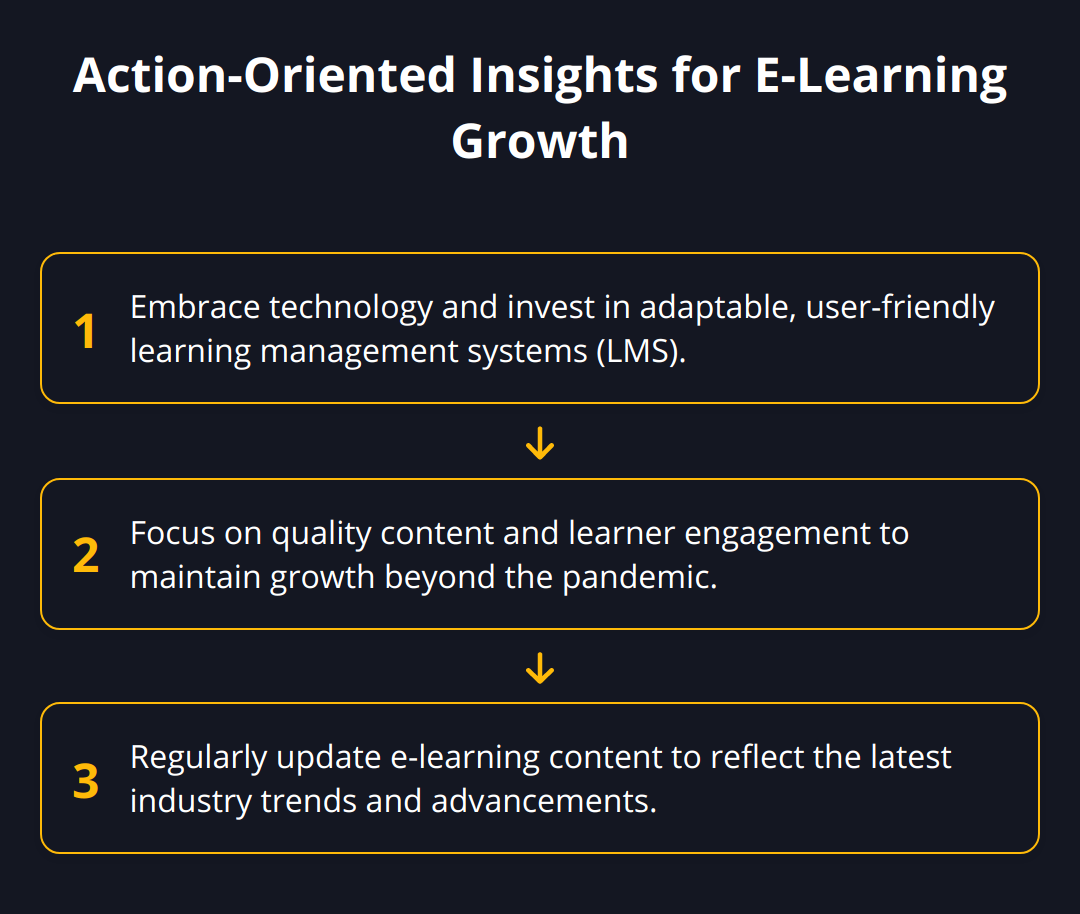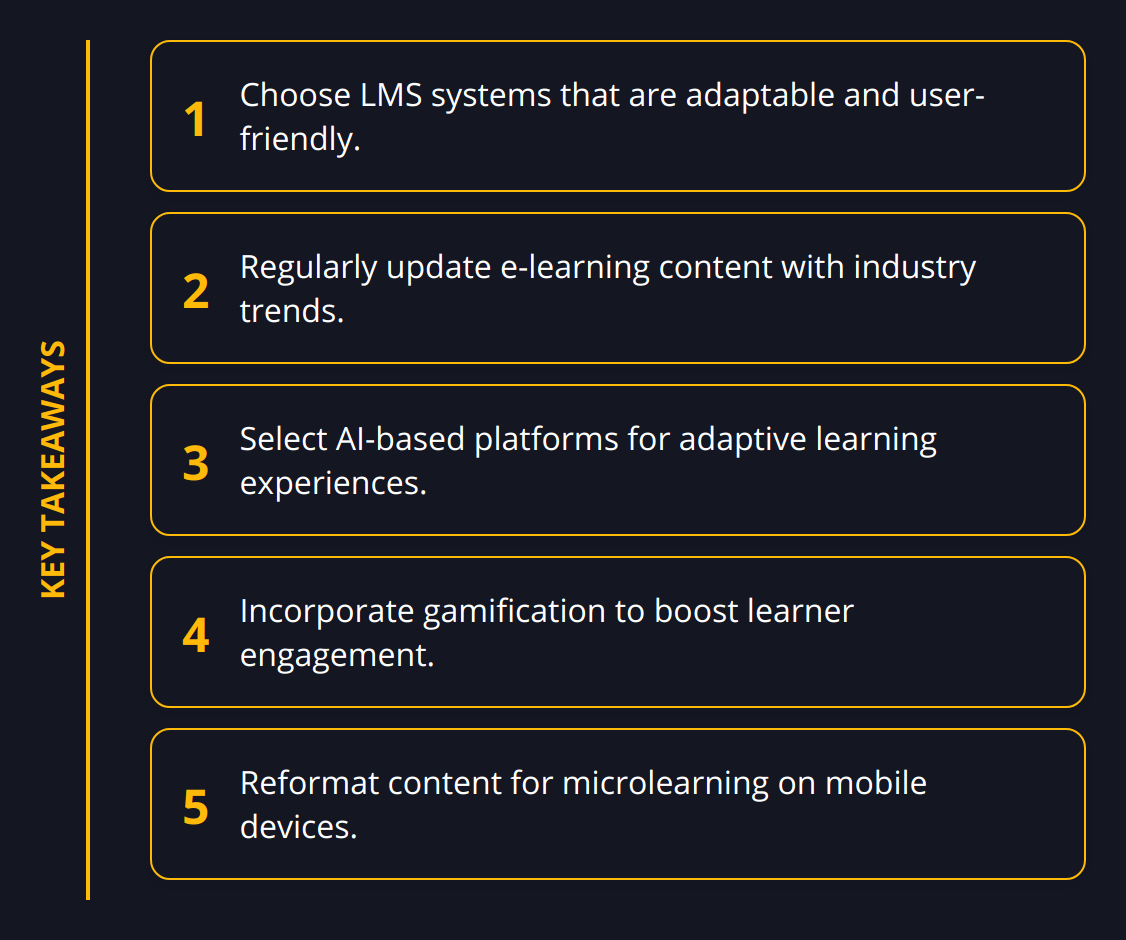The e-learning landscape is evolving at a rapid pace, shaping the way we acquire knowledge and skills. At Newroom Connect, we’ve observed a surge in demand for online learning, pushed even further by recent global events. Advancements in technology and changing work dynamics are contributing to this educational revolution. Let’s explore the burgeoning e-learning industry, its driving factors, and the technologies propelling it forward.
E-Learning Market Expansion
The e-learning industry is witnessing an unprecedented expansion, largely fueled by a rise in demand for online degree programs. Universities are increasingly offering online bachelor’s, master’s, and doctoral programs to cater to students who require flexibility due to work commitments or personal circumstances. In effect, a growing number of students are opting for these programs as they can advance their knowledge and skills without being physically present on campus.

For instance, the United States is seeing a significant shift with leading institutions embracing this trend, now considered a mainstream pathway to higher education.
Parallel to this, there is a marked increase in personalized learning experiences provided by learning platforms. These platforms are harnessing the dual powers of data analysis and artificial intelligence (AI) to tailor content to individual learning styles and paces. Machine Learning algorithms analyze students’ performance and preferences to adjust the curriculum dynamically, ensuring a more engaging and effective learning journey.
The COVID-19 pandemic has unmistakably accelerated the growth of e-learning. With the necessity of remote work and social distancing, businesses and educational institutions were compelled to shift online. This not only sustained the continuity of learning and professional development during the crisis but also highlighted the potential for scalability and cost-effectiveness in virtual learning environments. According to recent statistics, the global eLearning market is on a trajectory to reach a market size of $374 billion by 2026.

For those involved in the e-learning industry or considering it as an avenue for growth, here are some action-oriented insights:
-
Embrace technology and invest in learning management systems (LMS) that offer adaptability and user-friendly experiences.
-
Look beyond the pandemic’s push and focus on quality content and learner engagement to maintain momentum.
-
Regularly update your e-learning content to reflect the latest industry trends and technological advancements.
The future of education and professional development is unequivocally digital. Riding the wave of these market trends ensures a competitive edge and democratizes learning for a wider audience across the globe.
Driving Forces in E-Learning Growth
The rapid expansion of the e-learning industry is unquestionably not just a trend but a significant shift in education and professional development. The momentum behind this growth can be attributed to three main factors: flexibility, cost-effectiveness, and the need for continuous upskilling.

Flexibility and Accessibility for Learners Everywhere
The digital nature of e-learning breaks down geographical barriers, offering a learning solution that’s accessible to anyone with an internet connection. This has been particularly advantageous for people living in remote areas or those with responsibilities that prevent them from attending traditional classes. E-learning provides the ability to learn anytime and anywhere, which is why it resonates deeply with today’s learners. As a result, online learning platforms are seeing a surge in user registrations.
Cost-Effectiveness Compared to Traditional Education
When it comes to financials, e-learning often has the upper hand over brick-and-mortar education due to lower associated costs. Traditional education can come with a hefty price tag once you factor in expenses like transportation, housing, and materials. E-learning, however, typically requires a much smaller investment, making it an attractive and practical alternative for cost-conscious learners.
For example, individuals and organizations looking to trim budgets can find tremendous value in LMS solutions. Businesses can provide comprehensive training to employees without the need for expensive face-to-face sessions, travel, or even printed materials—often yielding significant savings. These cost comparisons between traditional and virtual learning resources underscore the economic advantage of e-learning platforms.
Continuous Upskilling Needs in a Rapidly Changing Job Market
The global job market is in constant flux due to technological advances and shifting economic tides. This has instigated an ever-present need for workers to acquire new skills or improve existing ones. E-learning is the most versatile and scalable way to meet this demand, with courses available in everything from soft skills to specialized technical proficiencies. In sectors like IT and digital marketing, where the pace of change is particularly swift, professionals often turn to online courses to stay relevant.

Here are some practical points to consider:
-
Adapt Learning to Fit Your Life: E-learning allows you to integrate education into your busy schedule, not the other way around.
-
Research Before You Invest: Evaluate the cost benefits of e-learning programs compared to traditional education—often, the savings are substantial.
-
Pursue Upskilling Periodically: With a fast-changing professional landscape, continually update your skills through online courses to maintain a competitive edge.
In summary, the e-learning industry’s growth drivers are integral to creating a more inclusive, affordable, and up-to-date educational ecosystem. By understanding the dynamics of flexibility, cost-saving, and the requirement for continual learning, one can fully harness the transformative power of e-learning.
Harnessing Tech for Smarter E-Learning
The evolution of technology has been pivotal in advancing e-learning from a niche to a norm. As we embrace this digital renaissance in education, the emphasis on personalized learning has become non-negotiable. AI and machine learning are not just buzzwords; they’re the engines driving the creation of custom learning experiences that adapt in real-time to the learner’s abilities and preferences. The data amassed by these intelligent systems feeds into complex algorithms that tailor coursework to challenge and support learners at every step.
What does this mean in practice? E-learning platforms can now predict which subjects will be tricky for users and provide additional resources to tackle them head-on. For instance, if a course participant is struggling with a particular concept, the platform can automatically offer supplementary material or adjust the difficulty level, making the learning process more effective and far less frustrating for the user.
Gamification is another aspect of e-learning that can’t be ignored. It’s turning tedious study sessions into riveting challenges, propelling user engagement to new heights. By embedding elements like points scoring, competitions, and leaderboards, e-learning is seeing increased completion rates and improved retention. Simply put, when learners enjoy the process, they’re more likely to stick with it and succeed.

Mobile learning and microlearning have also struck a chord with learners worldwide. Bite-sized lessons that fit into busy schedules are a must, as people want to learn while on the go. E-learning tools optimized for smartphones and tablets meet this demand by providing focused, short-form content that is coherent and highly digestible. The growth in this sector is a strong indicator that mobile-friendly learning isn’t just preferred; it’s expected.
Looking to integrate these technologies into your e-learning strategy? Here’s some actionable advice:
-
Upgrade to Adaptive Platforms: Select an LMS that proactively responds to learners’ needs using AI.
-
Engage Learners with Gamification: Use engagement strategies that incorporate game-like features to keep learners motivated.
-
Transition to Microlearning: Reconfigure your content into smaller, focused modules that cater to mobile users.
As we push forward, these technological developments in e-learning are not just enhancing education—they’re reshaping it. Embracing these innovations is vital for any education provider looking to deliver exceptional and efficient learning experiences.
Navigating E-Learning Challenges
The e-learning industry’s growth trajectory presents unique challenges that demand pragmatic solutions to ensure quality education that is accessible and current. Laying out strategies to overcome these hurdles involves clear actions, committed to improving the online learning experience for everyone involved.
Quality and Accreditation Standards
High educational standards and program credibility are non-negotiable for learners investing their time and resources into e-learning. Accreditation remains a key concern for online institutions as it assures students that they’re receiving a recognized and respected education. Innovative e-learning providers must therefore strive to meet, if not exceed, the rigorous standards set for traditional education. Offering transparent and continuous self-improvement processes paves the way for maintaining the high caliber of online programs.
Actionable steps include:
-
Seeking and maintaining accreditation from recognized bodies.
-
Establishing robust systems for course review and feedback.
-
Implementing peer review processes to ensure academic integrity.
Tackling the Digital Divide
While e-learning is inherently digital, not every potential learner has equal access to digital technologies. Closing this gap is vital to making e-learning inclusive. This means investing in solutions to provide affordable devices, software, and internet access to underserved communities.
Solutions involve:
-
Partnering with organizations to subsidize technology for low-income learners.
-
Developing low-bandwidth alternatives for those with limited internet access.
-
Offering downloadable resources that can be used offline.
Keeping Content Fresh and Engaging
The only constant in technology and industry knowledge is change. Keeping e-learning materials up-to-date is a challenge that providers must consistently address to deliver value to learners. This entails regular audits of course material and a commitment to continuous improvement. By incorporating the latest industry insights and feedback from learners, e-learning can be a dynamic tool for both personal and professional growth.
Recommendations for updated content:
-
Schedule frequent course evaluations and updates.
-
Create content that’s easily modifiable to adapt to new information.
-
Use analytics to identify which content is engaging and effective.
Incorporating these hands-on strategies ensures that e-learning not only remains relevant and resourceful but also serves as a catalyst for success in an increasingly digital world. The way forward involves an unwavering commitment to providing learners with the tools and knowledge to excel, keeping pace with global standards and technological advancements.
Final Thoughts
Reflecting on the vast growth of the e-learning industry, we at Newroom Connect recognize the intertwining roles of flexibility, cost-effectiveness, and the imperative of continuous upskilling that have largely powered this educational paradigm shift. These elements have been instrumental in fostering an environment that allows individuals to tailor their educational pursuits to their unique lifestyles and career paths.

The importance of overcoming industry challenges such as quality assurance, equal access, and keeping educational content relevant cannot be overstated. Our commitment to addressing these hurdles is reflected in the practical advice offered, aimed at guiding learners and educators towards meaningful e-learning experiences.
Looking to the future, the e-learning industry’s trajectory promises to redefine and expand the horizons of knowledge dissemination. As we endeavor to create immersive digital environments, including virtual trade fairs and virtual showrooms, we position ourselves as catalysts for innovation and learning. Our work in developing intuitive e-learning platforms that serve diverse corporate and educational needs is a testament to this future outlook.
Expect to see significant strides in personalized learning, with continued emphasis on AI and adaptive learning technologies to meet growing demands for tailored education. The creative fusion of gamification and microlearning is poised to keep learners engaged, as we adapt to an increasingly digital-first world.
In summary:
-
Flexibility, affordability, and upskilling define e-learning’s appeal.
-
Overcoming industry challenges is central to quality online education.
-
Technology and learner-centric approaches will shape e-learning’s future.
Supporting growth and accessibility in e-learning is more than a goal—it’s an ongoing journey that we, at Newroom Connect, are proud to be part of. Embrace the digital revolution in education with us and explore how our solutions can enhance your company’s or project’s knowledge transfer. Learn more about our offerings and join us as we pave the way towards a more innovative and connected learning landscape at Newroom Connect.
The e-learning wave is here to stay, and it is undeniably reshaping learning as we know it, making it more dynamic, engaging, and accessible than ever before.


